Mechanical Properties of Rock-like Materials Under Disturbance Loads at Different Lateral Pressures
Abstract
1. Introduction
2. Experimental Methodology
2.1. Specimen Preparation
2.2. Testing System and Loading Procedure
- Conducting biaxial static compression tests on specimens under varying lateral pressures at a loading rate of 1 kN/s to determine the biaxial compressive strength σbcs for each lateral pressure.
- Using 80% of the σbcs under each lateral pressure as the average stress σ1 for cyclic disturbance loads, and 20% of σbcs as the amplitude σs of the disturbance loads, performing cyclic disturbance tests until specimen failure. The specific steps for the cyclic disturbance test involve applying loads along the X-axis and Z-axis at a rate of 1 kN/s, maintaining the preset lateral pressure σ2 on the X-axis, loading the Z-axis to the preset average cyclic disturbance stress σ1, and then subjecting the specimen to disturbance loads until failure with a sine-wave disturbance waveform at a frequency of 2 Hz. The failure process is recorded using a camera. Figure 1c,d are the compression diagram and stress path diagram of the specimen, respectively.
3. Experimental Results and Analysis
3.1. Cyclic Disturbance Test Results
3.2. Mechanical Properties of Specimens
3.2.1. Stress–Strain Curve
- The presence of lateral pressure causes the specimens to be in a compressed state in the transverse direction during the initial loading stage, with the initial strain on the X-axis being greater than zero. Higher lateral pressure results in a larger area under the trans-verse stress–strain curve, indicating more energy stored in the transverse direction.
- At the initial stage of static load application, the internal cracks of the specimens compact rapidly due to biaxial pressure, reducing the proportion of the axial compaction stage as lateral pressure increases.
- In the late stage of static load application, the proportion of the axial yield stage increases, suggesting that increasing lateral pressure genuinely enhances the bearing capacity of the rocks.
- In the stage of disturbance load, with the increase in disturbance times, the hysteretic curve changes from dense to sparse when the lateral pressure is 2 MPa, while the hysteretic curve grows more evenly when the lateral pressure is 4 MPa and 6 MPa, and the hysteretic curve is denser when the lateral pressure is 6 MPa, which indicates that the actual strain growth of the specimen slows down in a single cycle after the lateral pressure increases.
3.2.2. Deformation Characteristics
3.2.3. Strength Characteristics
3.3. Crack Evolution Process and Failure Characteristics of Gypsum Specimens
3.3.1. Crack Evolution Process
3.3.2. Failure Characteristics of Specimens
4. Discussion
4.1. Characteristics of Damage Variables of Specimens Under Different Lateral Pressures
4.2. Failure Mechanism of Rock Under Disturbed Load Under Different Lateral Pressures
5. Conclusions
- The lateral pressure significantly enhances the ability of the specimen to resist the disturbance load. With the increase in lateral pressure, the number of failure cycles increases, the compaction stage decreases, the yield stage expands, and the hysteresis curve of the failure stage under the disturbance load is denser.
- Under a constant number of cyclic disturbances, the increase in lateral pressure reduces the ability of lateral and axial deformation, while increasing the elastic modulus and the average number of cycles of failure. Under constant lateral pressure, the increase in cyclic disturbances times leads to the continuous increase in residual plastic strain and the decrease in elastic modulus.
- The application of disturbance loads leads to more pronounced free-surface spalling and peeling of gypsum specimens, which accelerates the failure rate under different lateral pressures.
- The lateral pressure level significantly affects the crack evolution and failure behavior of gypsum specimens. The lower lateral pressures mainly lead to tensile cracking and tensile splitting failure, while higher lateral pressures leading to the initial cracking are not obvious. The failure characteristics of the specimen are shear fracture at both ends and tensile fracture in the middle.
Author Contributions
Funding
Institutional Review Board Statement
Informed Consent Statement
Data Availability Statement
Conflicts of Interest
References
- Geranmayeh Vaneghi, R.; Thoeni, K.; Dyskin Arcady, V.; Sharifzadeh, M.; Sarmadivaleh, M. Strength and Damage Response of Sandstone and Granodiorite under Different Loading Conditions of Multistage Uniaxial Cyclic Compression. Int. J. Geomech. 2020, 20, 04020159. [Google Scholar] [CrossRef]
- Liu, Y.; Dai, F.; Dong, L.; Xu, N.; Feng, P. Experimental Investigation on the Fatigue Mechanical Properties of Intermittently Jointed Rock Models Under Cyclic Uniaxial Compression with Different Loading Parameters. Rock Mech. Rock Eng. 2018, 51, 47–68. [Google Scholar] [CrossRef]
- Si, X.; Gong, F. Strength-weakening effect and shear-tension failure mode transformation mechanism of rockburst for fine-grained granite under triaxial unloading compression. Int. J. Rock Mech. Min. Sci. 2020, 131, 104347. [Google Scholar] [CrossRef]
- Wang, Y.; Zhao, L.; Han, D.-h.; Qin, X.; Ren, J.; Wei, Q. Micro-mechanical analysis of the effects of stress cycles on the dynamic and static mechanical properties of sandstone. Int. J. Rock Mech. Min. Sci. 2020, 134, 104431. [Google Scholar] [CrossRef]
- Gong, F.; Yan, J.; Li, X.; Luo, S. A peak-strength strain energy storage index for rock burst proneness of rock materials. Int. J. Rock Mech. Min. Sci. 2019, 117, 76–89. [Google Scholar] [CrossRef]
- Wu, Q.-h.; Weng, L.; Zhao, Y.-l.; Feng, F. Influence of infilling stiffness on mechanical and fracturing responses of hollow cylindrical sandstone under uniaxial compression tests. J. Cent. South Univ. 2021, 28, 2485–2498. [Google Scholar] [CrossRef]
- Zhang, Q.B.; Zhao, J. A Review of Dynamic Experimental Techniques and Mechanical Behaviour of Rock Materials. Rock Mech. Rock Eng. 2014, 47, 1411–1478. [Google Scholar] [CrossRef]
- Bello, I.; Martínez-Abella, F.; Wardeh, G.; González-Fonteboa, B. Complete stress-strain analysis of masonry prisms under compressive loading-unloading cycles through digital image correlation. Eng. Struct. 2024, 298, 117088. [Google Scholar] [CrossRef]
- Liu, Z.; Cao, P.; Zhao, Q.; Cao, R.; Wang, F. Deformation and damage properties of rock-like materials subjected to multi-level loading-unloading cycles. J. Rock Mech. Geotech. Eng. 2023, 15, 1768–1776. [Google Scholar] [CrossRef]
- Meng, Q.-b.; Liu, J.-f.; Huang, B.-x.; Zhang, Z.-z.; Long, J.-k.; Wu, J.-y. Experimental analysis of the height–diameter ratio effect of rock energy under uniaxial cyclic loading–unloading conditions. Bull. Eng. Geol. Environ. 2023, 82, 283. [Google Scholar] [CrossRef]
- Zhang, C.; Wang, Y.; Ruan, H.; Ke, B.; Lin, H. The strain characteristics and corresponding model of rock materials under uniaxial cyclic load/unload compression and their deformation and fatigue damage analysis. Arch. Appl. Mech. 2021, 91, 2481–2496. [Google Scholar] [CrossRef]
- Gong, F.-Q.; Wu, C.; Luo, S.; Yan, J.-Y. Load–unload response ratio characteristics of rock materials and their application in prediction of rockburst proneness. Bull. Eng. Geol. Environ. 2019, 78, 5445–5466. [Google Scholar] [CrossRef]
- Zhou, X.-P.; Jiang, D.-C.; Zhao, Z. Digital Evaluation of Micro-Pore Water Effects on Mechanical and Damage Characteristics of Sandstone Subjected to Uniaxial, Cyclic Loading–Unloading Compression by 3D Reconstruction Technique. Rock Mech. Rock Eng. 2022, 55, 147–167. [Google Scholar] [CrossRef]
- Huang, Y.; Xie, T.; Xu, X.; Ding, Q. Experimental study of creep Poisson ratio of hydraulic concrete under multi-age loading-unloading conditions. Constr. Build. Mater. 2021, 310, 125269. [Google Scholar] [CrossRef]
- Tian, W.-L.; Yang, S.-Q.; Wang, J.-G.; Dong, J.-P. Failure behavior of the thermal treated granite under triaxial cyclic loading–unloading compression. Geomech. Geophys. Geo-Energy Geo-Resour. 2021, 7, 19. [Google Scholar] [CrossRef]
- Yuan, C.; Guo, Y.; Wang, W.; Cao, L.; Fan, L.; Huang, C. Study on “Triaxial Loading-Unloading-Uniaxial Loading” and Microscopic Damage Test of Sandstone. Front. Earth Sci. 2020, 8, 78. [Google Scholar] [CrossRef]
- Wang, C.; Zhang, D.; Yu, B.; Li, S. Deformation and Seepage Characteristics of Coal Under True Triaxial Loading–Unloading. Rock Mech. Rock Eng. 2023, 56, 2673–2695. [Google Scholar] [CrossRef]
- Tan, H.; Liu, H.; Shi, X.; Ma, H.; Qiu, X.; Guo, Y.; Ban, S. Mechanical and Acoustic Response of Low-Permeability Sandstone under Multilevel Cyclic Loading-Unloading Stress Paths. Energies 2023, 16, 6821. [Google Scholar] [CrossRef]
- Ning, Z.; Xue, Y.; Li, Z.; Su, M.; Kong, F.; Bai, C. Damage Characteristics of Granite Under Hydraulic and Cyclic Loading–Unloading Coupling Condition. Rock Mech. Rock Eng. 2022, 55, 1393–1410. [Google Scholar] [CrossRef]
- Isakov, M. Cyclic Impact Test with the Hopkinson Bar: Application to Granite. J. Dyn. Behav. Mater. 2024, 10, 75–91. [Google Scholar] [CrossRef]
- Sun, B.; Yang, P.; Liu, S.; Zeng, S. Impact dynamic characteristics and constitutive model of granite damaged by cyclic loading. J. Mater. Res. Technol. 2023, 24, 333–345. [Google Scholar] [CrossRef]
- Zha, X.; Jiang, F.; Xu, X. Investigating the high frequency fatigue failure mechanisms of mono and multilayer PVD coatings by the cyclic impact tests. Surf. Coat. Technol. 2018, 344, 689–701. [Google Scholar] [CrossRef]
- Dai, B.; Shan, Q.-w.; Chen, Y.; Luo, X.-y. Mechanical and energy dissipation characteristics of granite under cyclic impact loading. J. Cent. South Univ. 2022, 29, 116–128. [Google Scholar] [CrossRef]
- Luo, N.; Suo, Y.; Zhang, H.; Chai, Y.; Zhai, C.; Qu, Z.; Bai, G. On dynamic behaviors and failure of bedding coal rock subjected to cyclic impact. Explos. Shock. Waves 2023, 43, 14. (In Chinese) [Google Scholar] [CrossRef]
- Fan, L.F.; Li, H.; Xi, Y.; Wang, M. Effect of Cyclic Impact on the Dynamic Behavior of Thermally Shocked Granite. Rock Mech. Rock Eng. 2024, 57, 4473–4491. [Google Scholar] [CrossRef]
- Du, K.; Yang, C.; Su, R.; Tao, M.; Wang, S. Failure properties of cubic granite, marble, and sandstone specimens under true triaxial stress. Int. J. Rock Mech. Min. Sci. 2020, 130, 104309. [Google Scholar] [CrossRef]
- Jiang, Q.; Su, G.; Feng, X.-t.; Chen, G.; Zhang, M.-z.; Liu, C. Excavation Optimization and Stability Analysis for Large Underground Caverns Under High Geostress: A Case Study of the Chinese Laxiwa Project. Rock Mech. Rock Eng. 2019, 52, 895–915. [Google Scholar] [CrossRef]
- Wang, S.; Li, X.; Yao, J.; Gong, F.; Li, X.; Du, K.; Tao, M.; Huang, L.; Du, S. Experimental investigation of rock breakage by a conical pick and its application to non-explosive mechanized mining in deep hard rock. Int. J. Rock Mech. Min. Sci. 2019, 122, 104063. [Google Scholar] [CrossRef]
- Bobet, A.; Einstein, H.H. Fracture coalescence in rock-type materials under uniaxial and biaxial compression. Int. J. Rock Mech. Min. Sci. 1998, 35, 863–888. [Google Scholar] [CrossRef]
- Choo, J.; Sun, Y.; Fei, F. Size effects on the strength and cracking behavior of flawed rocks under uniaxial compression: From laboratory scale to field scale. Acta Geotech. 2023, 18, 3451–3468. [Google Scholar] [CrossRef]
- Ge, Y.; Ren, G.; Zhang, C.; Shi, Y.; Zhang, L. Study on Damage Characteristics and Failure Modes of Gypsum Rock under Dynamic Impact Load. Materials 2023, 16, 3711. [Google Scholar] [CrossRef] [PubMed]
- Chen, X.; Tang, M.; Tang, C. Effect of Confining Pressure on the Damage Evolution and Failure Behaviors of Intact Sandstone Samples During Cyclic Disturbance. Rock Mech. Rock Eng. 2022, 55, 19–33. [Google Scholar] [CrossRef]
- Liu, E.; He, S.; Xue, X.; Xu, J. Dynamic Properties of Intact Rock Samples Subjected to Cyclic Loading under Confining Pressure Conditions. Rock Mech. Rock Eng. 2011, 44, 629–634. [Google Scholar] [CrossRef]
- Song, H.; Duan, C.; Zhao, Y.; Teng, T.; Hu, S.; Wu, Y.; Gong, Z.; Jiang, Y.; Wu, J. Effect of cyclic loading-unloading on the mechanical anisotropy of coal under uniaxial compressive condition. Bull. Eng. Geol. Environ. 2024, 83, 131. [Google Scholar] [CrossRef]
- Cao, Y.; Yan, Q.; Zhang, S.; Cai, F. Experimental Research on Anisotropy Characteristics of Shale under Triaxial Incremental Cyclic Loading and Unloading. Appl. Sci. 2024, 14, 2602. [Google Scholar] [CrossRef]
- Xiao, J. Theoretical and Experimental Investigation on Fatigue Properties of Rock Under Cyclic Loading. Ph.D. Thesis, Central South University, Changsha, China, 2010. [Google Scholar]
- Wang, R.; Wei, C.; Liu, J. Macro and micro characteristics of jointed sandstone under cyclic loading and unloading. Chin. J. Rock Mech. Eng. 2023, 42, 810–820. [Google Scholar] [CrossRef]
- Zhang, W.; Guo, W.; Wang, Z. Influence of lateral pressure on mechanical behavior of different rock types under biaxial compression. J. Cent. South Univ. 2022, 29, 3695–3705. [Google Scholar] [CrossRef]


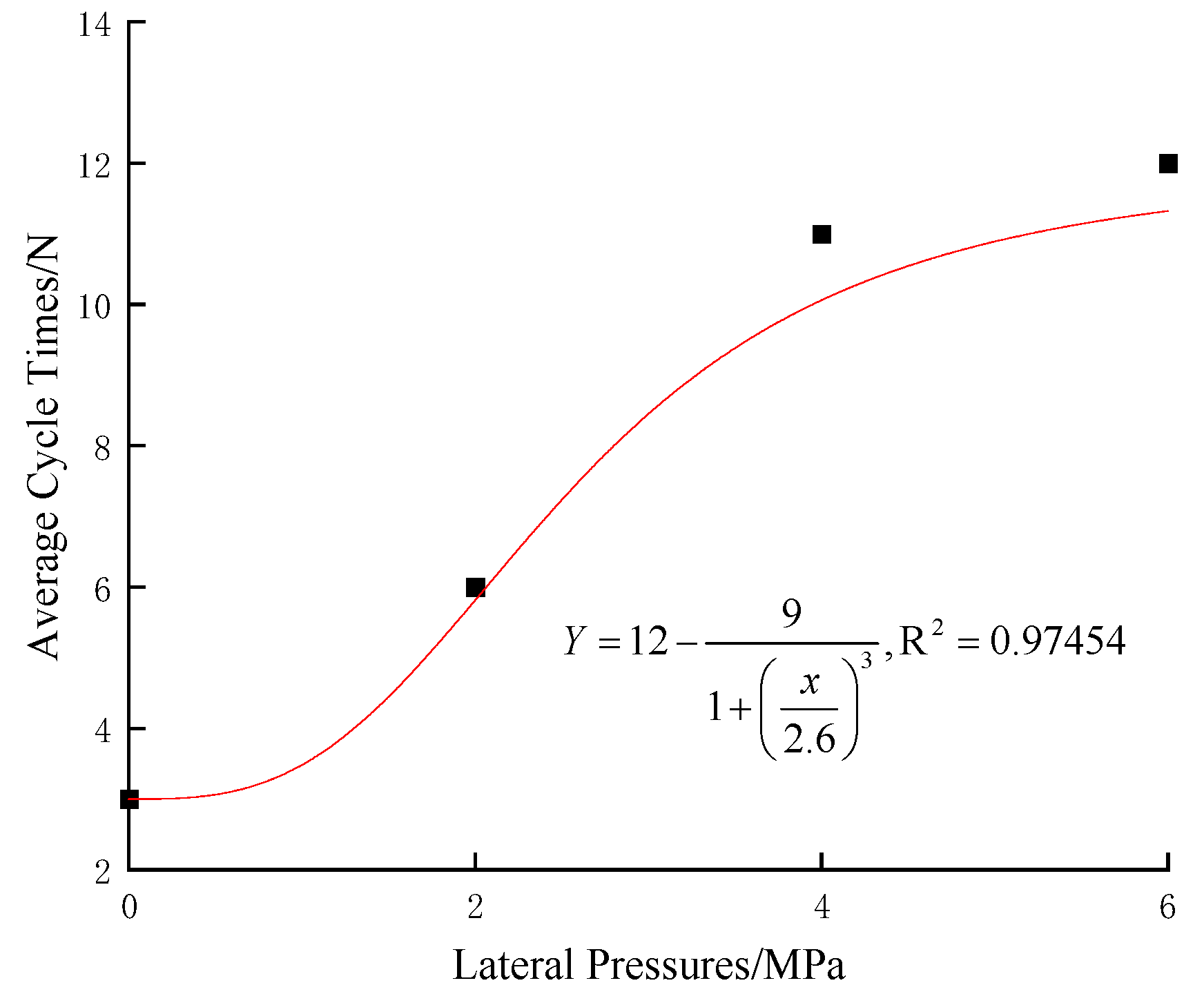
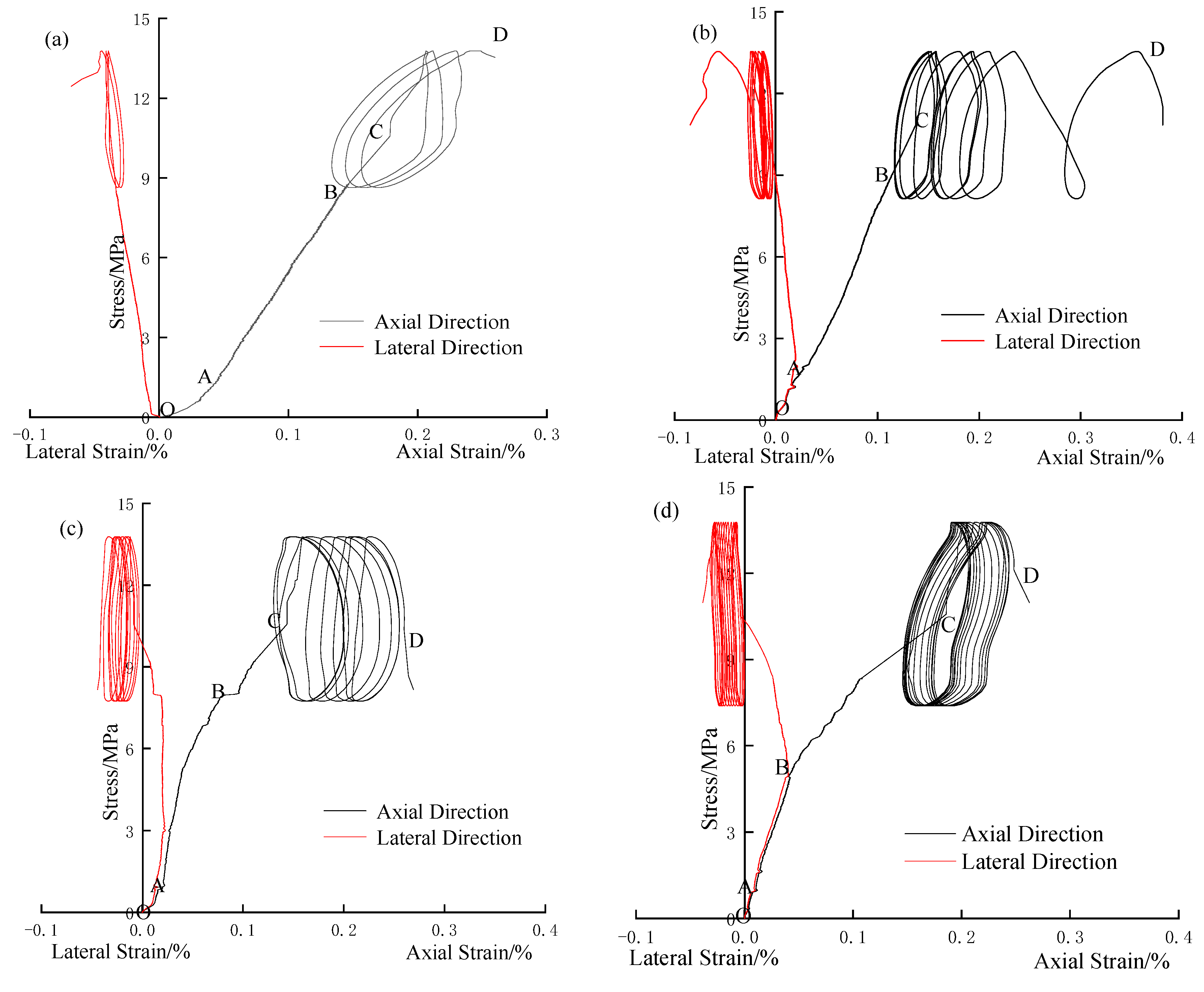


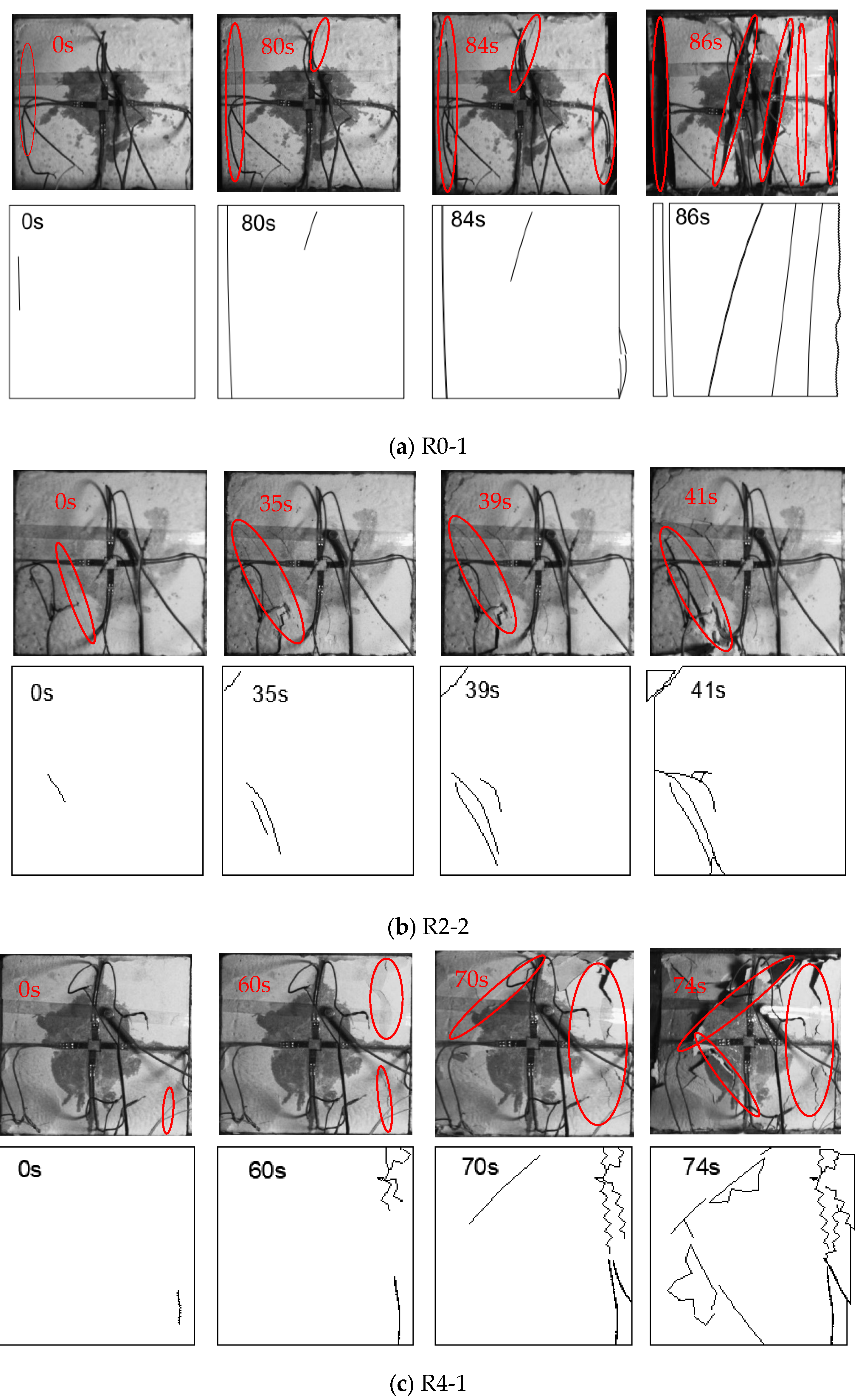
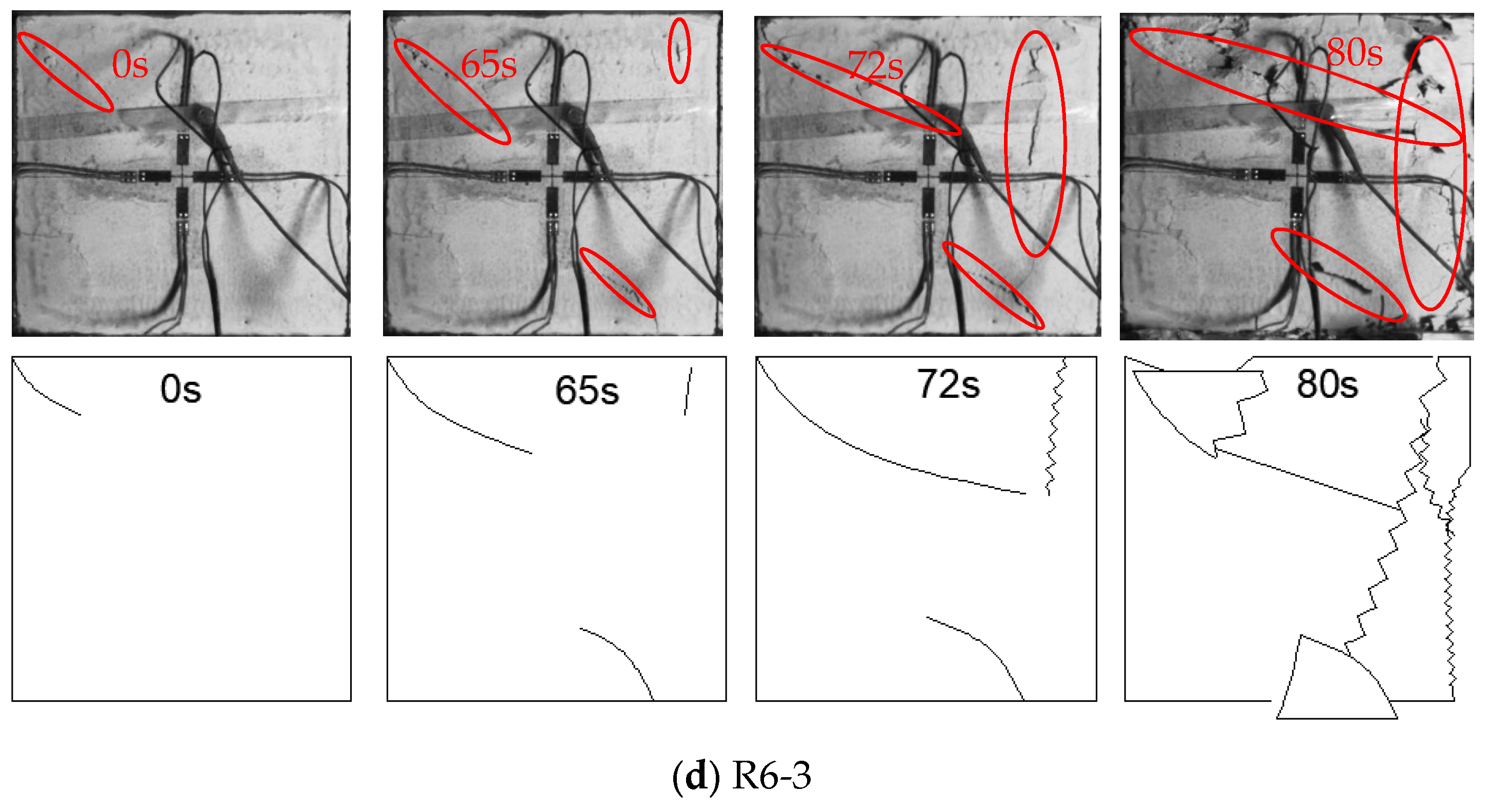
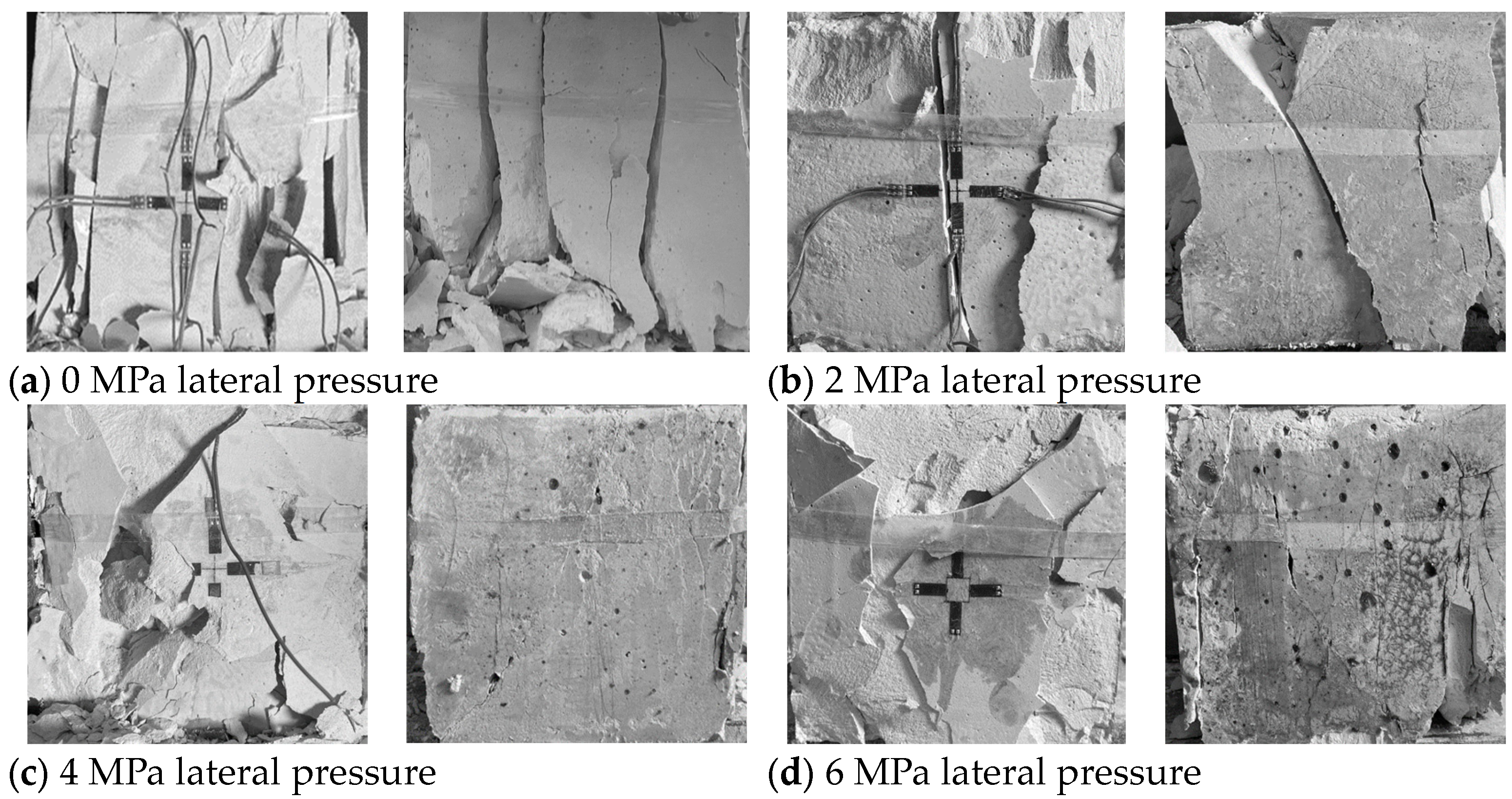
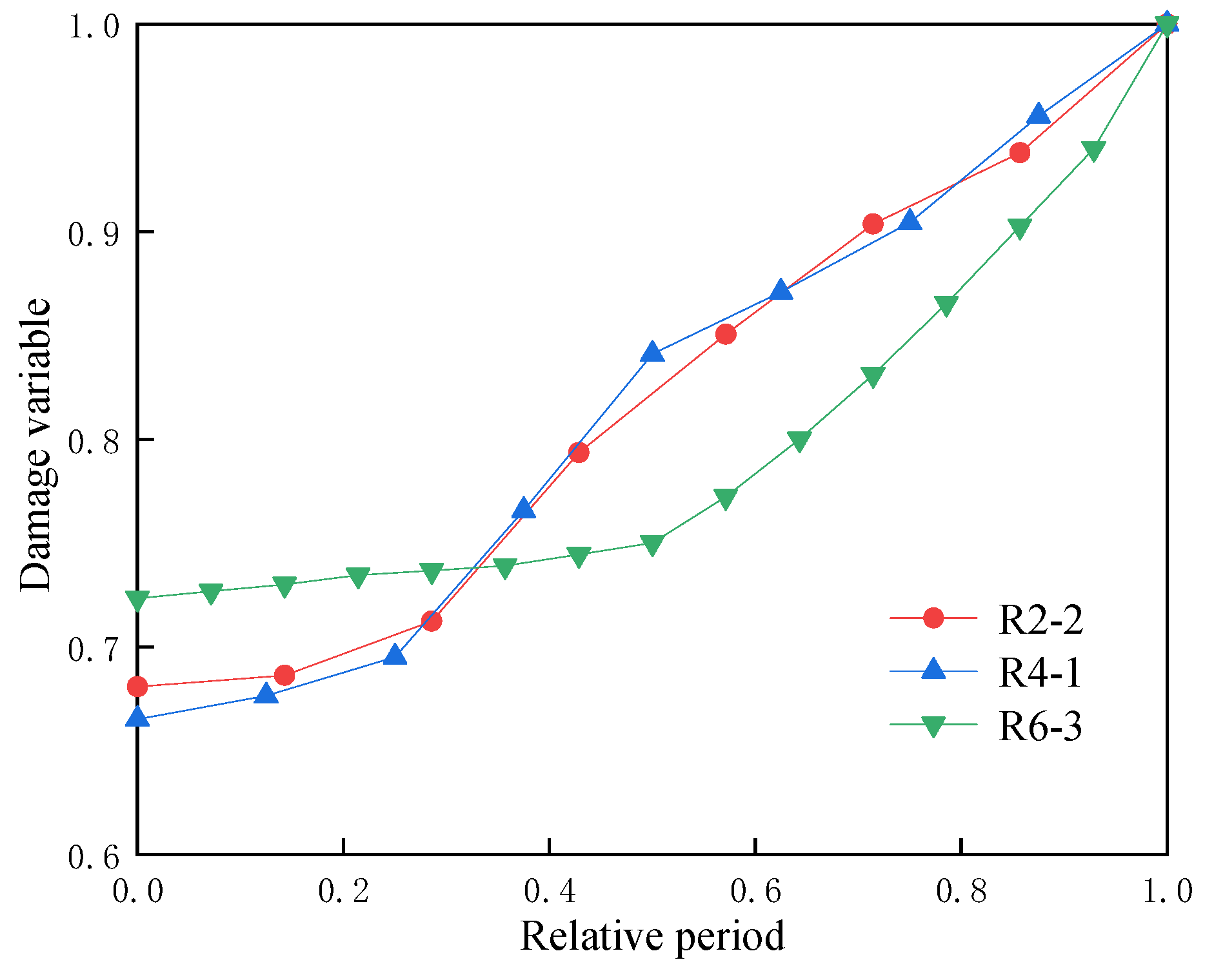
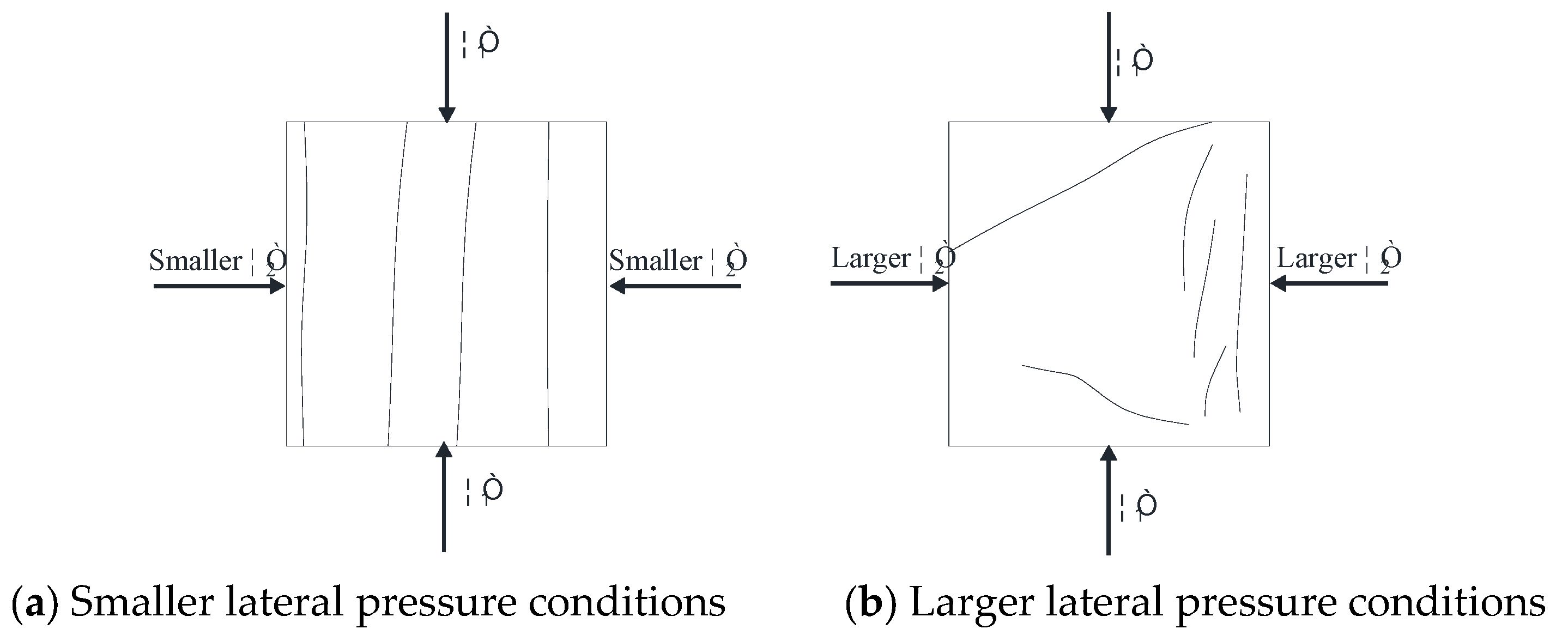
| Material Type | mgypsum:mwater | Compressive Strength/MPa | Internal Friction Angle/(°) | Elastic Modulus/GPa | Poisson’s Ratio | Density/g·cm−3 |
|---|---|---|---|---|---|---|
| Gypsum | 1:0.5 | 12.53 | 44.3 | 2.66 | 0.21 | 2.75 |
| Specimen Number | Lateral Stress σ2/MPa | Axial Stress σ1/MPa | Disturbance Amplitude σS/MPa | /Hz | Cycle Counts/ | Average Cycle Counts/ |
|---|---|---|---|---|---|---|
| R0-1 | 0 | 10.21 | 2.55 | 2 | 3 | 3 |
| R0-2 | 2 | |||||
| R0-3 | 3 | |||||
| R2-1 | 2 | 11.02 | 2.76 | 2 | 6 | 6 |
| R2-2 | 8 | |||||
| R2-3 | 4 | |||||
| R4-1 | 4 | 12.10 | 3.02 | 2 | 9 | 11 |
| R4-2 | 13 | |||||
| R4-3 | 10 | |||||
| R6-1 | 6 | 12.80 | 3.20 | 2 | 11 | 12 |
| R6-2 | 10 | |||||
| R6-3 | 15 |
Disclaimer/Publisher’s Note: The statements, opinions and data contained in all publications are solely those of the individual author(s) and contributor(s) and not of MDPI and/or the editor(s). MDPI and/or the editor(s) disclaim responsibility for any injury to people or property resulting from any ideas, methods, instructions or products referred to in the content. |
© 2024 by the authors. Licensee MDPI, Basel, Switzerland. This article is an open access article distributed under the terms and conditions of the Creative Commons Attribution (CC BY) license (https://creativecommons.org/licenses/by/4.0/).
Share and Cite
Liu, Y.; Zhao, F.; Wu, Q.; Ye, Z. Mechanical Properties of Rock-like Materials Under Disturbance Loads at Different Lateral Pressures. Materials 2024, 17, 5439. https://doi.org/10.3390/ma17225439
Liu Y, Zhao F, Wu Q, Ye Z. Mechanical Properties of Rock-like Materials Under Disturbance Loads at Different Lateral Pressures. Materials. 2024; 17(22):5439. https://doi.org/10.3390/ma17225439
Chicago/Turabian StyleLiu, Yonghong, Fujun Zhao, Qiuhong Wu, and Zhouyuan Ye. 2024. "Mechanical Properties of Rock-like Materials Under Disturbance Loads at Different Lateral Pressures" Materials 17, no. 22: 5439. https://doi.org/10.3390/ma17225439
APA StyleLiu, Y., Zhao, F., Wu, Q., & Ye, Z. (2024). Mechanical Properties of Rock-like Materials Under Disturbance Loads at Different Lateral Pressures. Materials, 17(22), 5439. https://doi.org/10.3390/ma17225439





